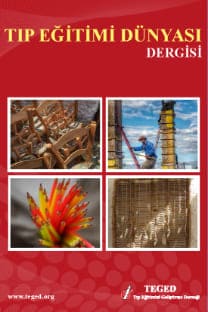Multidisipliner klinik staj programlarının geliştirilmesinde TEAD katkısına bir örnek: ACU Ortopedi/FTR Stajı
Dünyada 1950’lerden itibaren başlayan tıp eğitiminde entegre eğitim sistemleri , ülkemizde 1960'lı yıllardan itibaren giderek artan sayıda fakültede uygulanmaya başlamıştır. Tıp eğitim programlarındaki entegrasyon tıp fakülteleri tarafından uygulanmakta olsa da gerçek anlamda entegrasyonun gerçekleştirildiği konusunda belirgin farklılıklar ve sorunlar da bulunmaktadır. Klinik staj eğitimlerindeki entegrasyon ise oldukça farklı özellikler içermektedir, yatay dikey entegrasyon açısından taska dayalı öğrenme yöntemleri ile entegrasyon sağlanabildiği gibi disiplinler arası entegrasyon uygulamaları da vardır. Entegrasyonun eğitim içeriği ve eğitimin verilme yöntemleri açısından yapılanmasının yanı sıra ölçme değerlendirmesi de ayrı önem taşımaktadır. Bu makaledeki amaç ACU Tıp Fakültesi 5. Sınıf Ortopedi/FTR stajının TEAD ile ortak bir çalışma sonucu gerçekleştirdiği program geliştirme çalışmalarını tartışmaya açmak ve TEAD katkısı ile gelişen bir klinik eğitim programı geliştirme aşamalarını ortaya koymaktır. Süreçlerin yürütülmesinde öğretim üyelerinin bireysel motivasyonlarının varlığı başarıyı sağlayan önemli faktörlerden biridir. Klinik dönemde görev yapan öğretim üyelerinin hizmet iş yükleri nedeni ile karşılaşmış oldukları zorluklara rağmen birlikte çalışarak tıp eğitimine katkı sağlayan süreçler geliştirme konusunda istekli ve başarılı olacakları durumlar geliştirebildikleri bu çalışma süreci ile görülmüştür. TEAD’lar klinik dönemdeki bu multidisipliner çalışmalarda danışman rolünü etkin olarak sürdürmelidir.
An example of TEAD contribution to the development of multidisciplinary clinical clerckship programs: ACU Orthopedics / Physical Medicine and Rehabilitation Clerckship Program
IntroductionIntegrated education systems in medical education, which started in the world since the 1950s, have been applied in an increasing number of faculties since the 1960s in our country. Although the integration of medical education programs is implemented by medical schools, there are also significant differences and problems regarding the realization of integration. horizontal and vertical integration in clinical trainings has quite different and difficult features regarding both content and context. In addition, assessment has also of particular importance while structuring integration.AimThe aim of this article is to discuss the program development studies of the 5th grade Orthopedics / PTR clerkship of Acıbadem Universtity School of Medicine as a result of a joint study with Department of Medical Education (DME) and to reveal the stages of developing a clinical training program with the contribution of DME.ConclusionThe existence of individual motivations of the faculty members is one of the important factors in the success of the process. It was seen that, despite the difficulties faced by the service workloads of the faculty members working in the clinical period, they were able to work together and develop situations in which they would be successful and willing to develop processes that contribute to medical education. DMEs should effectively act as consultants in these multidisciplinary studies in the clinical period.
___
- Wall A., Leckie A. Curriculum Integration: An Overview. Current Issues in Middle Level Education, 2017; 22 (1): 36-40
- Harden RM. The integration ladder: a tool for curriculum planning and evaluation. Medical Education 2000;34:551-557.
- Şenol Y., Aktekin M. Tıp Eğitiminde Entegrasyon. Tıp Eğitimi Dünyası, 2003;13: 51-58
- https://www.acibadem.edu.tr/mezuniyet-oncesi
- http://kongre.teged.org/uploads/GiBtLCaL/media/utes-2017-bildiri-kitapcigi_gG5djEiE.pdf
- http://kongre.teged.org/uploads/Tr8J4Mvm/media/utes-2019-kitapcikpdf_4ailVrsC.pdf
